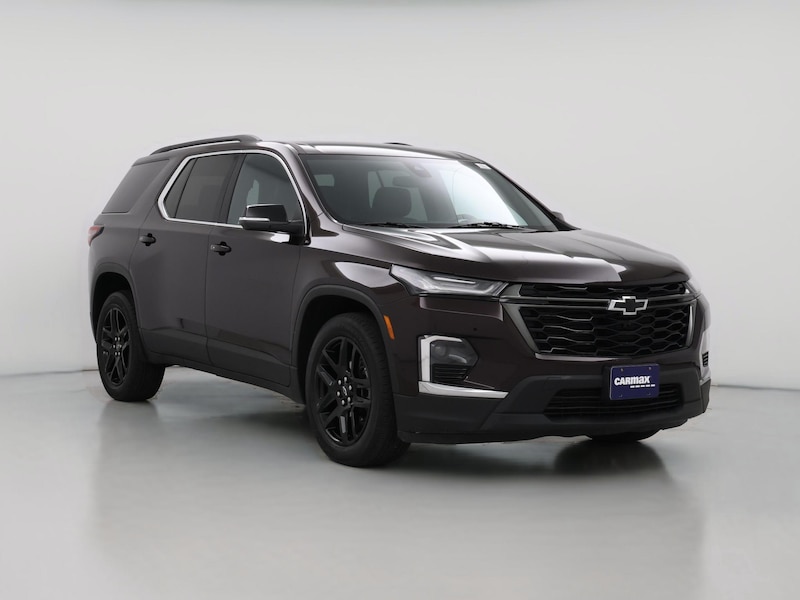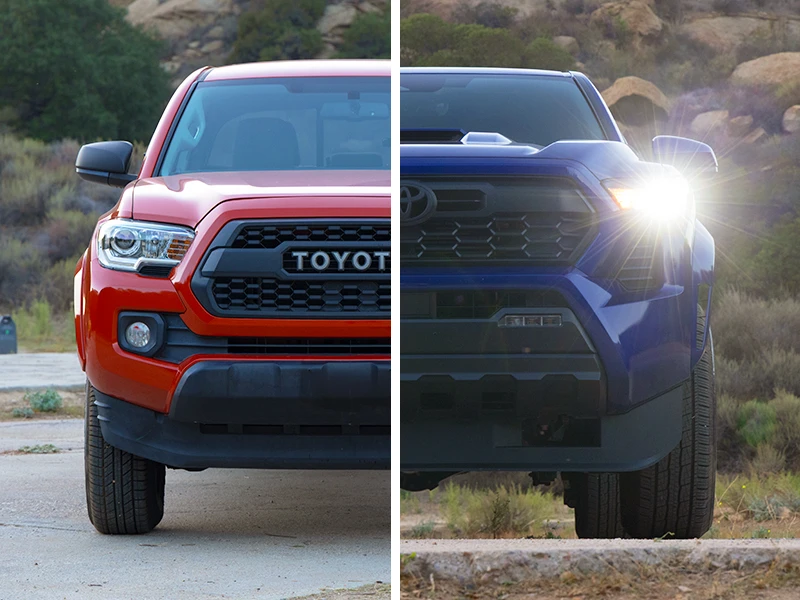Three-row SUVs for hauling your crew.
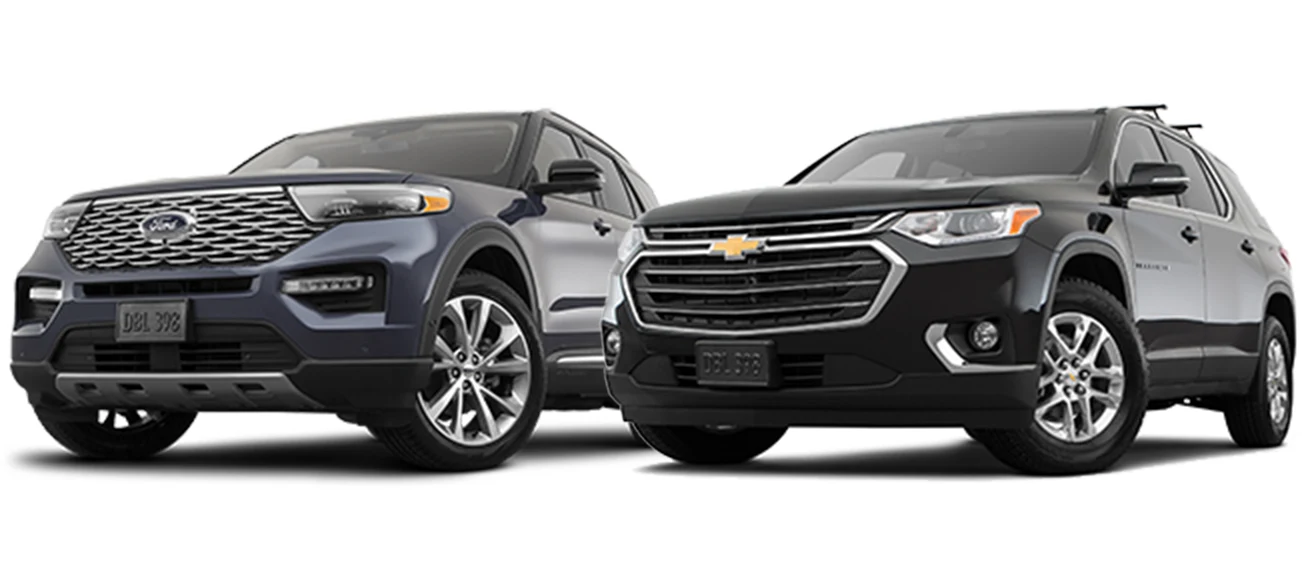
People, pets, and their accoutrements are some of the hallmarks of family life, and a three-row SUV is a great choice for getting all of them from place to place. But, equally, a large vehicle is also suited for busy professionals and couples who need that little extra space to accommodate all their hobbies.
Two vehicles that are up to the task are the Ford Explorer, a three-row SUV with seating for up to seven passengers, and the Chevrolet Traverse, which can shuttle up to eight people. Each has a number of amenities that should please even the most discerning travelers, like a bevy of cup holders, up-to-date infotainment systems, and available comfort features like seat heaters and premium audio systems.
We've made it easy for you to pick the one that matches your needs. Take a look at our comparison of the Ford Explorer and Chevrolet Traverse.
This article is part of our series comparing used SUVs. Looking for other feature-rich people haulers? Check out these articles:
Side-by-Side Comparison

2019 Ford Explorer | 2019 Chevrolet Traverse | |
|---|---|---|
Average Price | $30,500 | $31,000 |
Performance | ||
Base Engine | 3.5 V6 | 3.6L V6 |
Horsepower | 290 hp | 310 hp |
MPG | FWD: EPA-estimated 20 mpg combined; AWD: EPA-estimated 19 mpg combined | FWD: EPA-estimated 21 mpg combined; AWD: EPA-estimated 20 mpg combined |
Interior | ||
Seating | 7 | 8 |
Cargo Space | 21.0 behind third row/43.8 behind second row/80.7 with second and third-row seats folded | 23.0 behind third row/58.1 behind second row/98.2 with second and third-row seats folded |
Front Legroom | 42.9 inches | 41.0 inches |
Rear Legroom | 39.5 inches | 33.5 inches |
Overall Interior Space | 151.7 cu ft | 157.3 cu ft |
Ratings | ||
Safety Rating | 5 stars | 5 stars |
Tailpipe Emissions | 454 FWD/481 AWD grams per mile | 420 FWD/439 AWD grams per mile |
Features and Trim Options
Ford Explorer
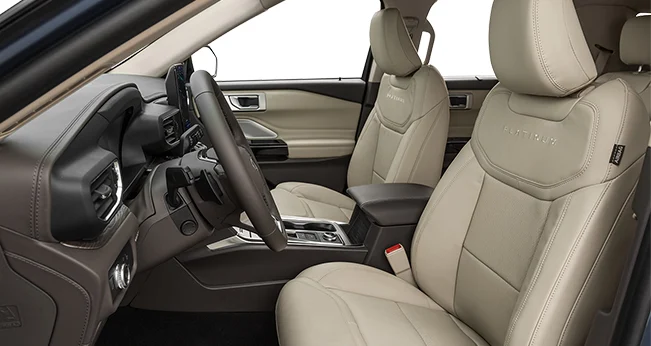
The spacious interior of the Ford Explorer makes it a great choice for large families, with seating for up to seven. There's room for everyone to spread out, making it ideal for long road trips with friends, too.
All models from 2017–2019 include these features:

Power-adjustable driver's seat
40/20/40 split second-row seat
Rearview camera
Liftgate window defroster
Chevrolet Traverse
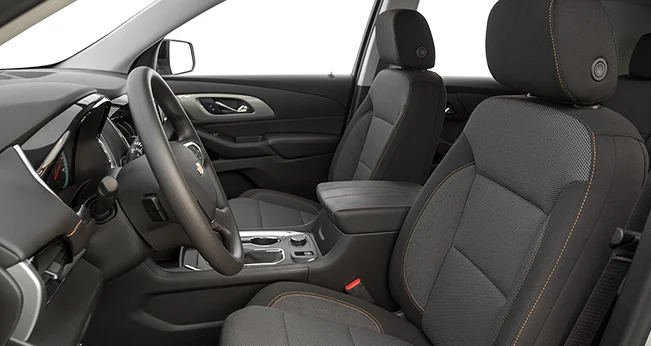
The Chevrolet Traverse is also a roomy SUV that could be a terrific fit for anyone looking for seating for eight, rather than seven.
Standard features on 2018–2021 models include:

Front-wheel drive (available all-wheel drive)
Rear seat reminder
Rear vision camera
Tri-zone automatic climate control
Engine Options
The 2017–2019 Ford Explorer is available with a choice of three powertrains, all paired to a six-speed automatic transmission. In the base trim, you can choose between a 2.3L four-cylinder or 3.5L V6 engine depending on how much hp you want. A turbocharged 3.5L V6 is included in the Sport and Platinum trims. Here's a rundown of the 2017–2019 Explorer's engine options:
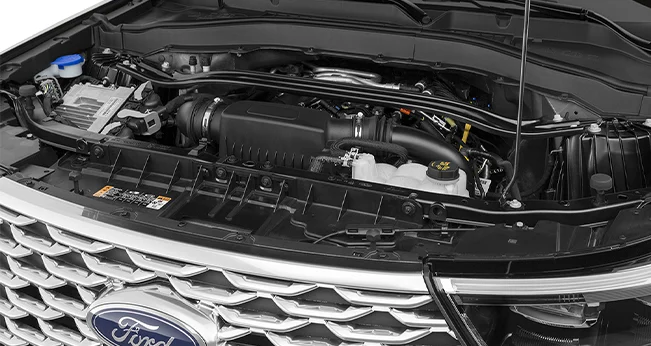
2.3L four-cylinder, 280 hp, 310 lb-ft of torque
3.5L V6, 290 hp, 255 lb-ft of torque
Turbocharged 3.5L V6, 365 combined hp, 350 lb-ft of torque
The 2018–2021 Chevrolet Traverse is available with one engine option paired to a nine-speed automatic transmission.

3.6L V6, 310 hp, 266 lb-ft of torque
Fuel Economy
If you want to go longer between trips to the gas station, the Traverse gets the highest mpg of these two vehicles with standard combustion engines. There is, however, a hybrid Explorer available that could also be a great choice—read on for the figures.
Chevrolet Traverse
The highest mpg from the 2018–2021 Traverse is available in trims equipped with front-wheel drive. These get an EPA-estimated 18 mpg city, 27 mpg highway, and 21 mpg combined with the V6.†† All-wheel drive drops the numbers slightly to an EPA-estimated 17 mpg city, 25 mpg highway, and 20 mpg combined with the V6.††
Ford Explorer
The 2020–2021 Ford Explorer has a wide range of engines and gets an equally wide range of fuel economy figures.
The best gas powertrain figures come from the 2.3L engine with front-wheel drive, which gets an EPA-estimated 24 mpg combined.††
Four-wheel drive with the 2.3L engine drops those figures slightly with an EPA-estimated 23 mpg combined.††
Either way, it exceeds what's offered by the Traverse. And when you're taking long trips with your family on a regular basis, those differences add up.
For the previous generation, 2017–2019 Ford Explorers are equipped with one of three engines and each gets different mpg figures:
Front-wheel drive and a 3.5L V6 will get an EPA-estimated 20 mpg combined.**
All-wheel drive decreases the numbers by a bit; the AWD 3.5L V6 will get an EPA-estimated 19 mpg combined.††
The FWD 2.3L four-cylinder engine reduces your trips to the pump, achieving an EPA-estimated 27 mpg combined.††
The 2.3L engine gets an EPA-estimated 21 mpg combined when equipped with all-wheel drive.††
If you opt for the Explorer Sport or Platinum trim, which have a twin-turbo V6, you'll see an EPA-estimated 16 mpg city, 22 highway, and 18 mpg combined.††
If you put a priority on making fewer trips to the pump, you should consider the 2020–2021 Ford Explorer Hybrid, which gets an EPA-estimated 27 mpg city, 28 mpg highway, and 27 mpg combined.††
Tech Features
The 2020–2021 Ford Explorer includes its well-regarded SYNC® 3 infotainment system as a standard feature along with available 4G LTE Wi-Fi connectivity for up to 10 devices and a six-speaker audio system.3 Other tech features on 2020–2021 Ford Explorer models include:
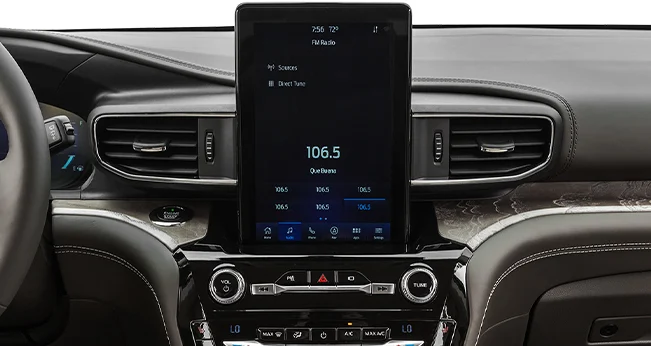
Eight-inch infotainment touchscreen
Apple CarPlay® and Android Auto™ connectivity
Navigation (optional on XLT)
Dual second-row charging outlets (standard on XLT)
The 2018–2021 Chevrolet Traverse includes standard Chevrolet Infotainment 3, which also has available 4G LTE Wi-Fi connectivity and a six-speaker audio system.3 Look out for these other features on 2018–2021 Traverse models:

Seven-inch infotainment touchscreen
Apple CarPlay and Android Auto connectivity
Navigation (Optional on LT Leather)
SiriusXM (Standard on LT Cloth)
Cargo Space
Fully redesigned for 2020, the Ford Explorer has 18.2 cu ft for cargo behind the third row, 47.9 cu ft behind the second row, and 87.8 cu ft behind the first row. It can also tow up to an estimated 5,600 pounds, when properly equipped, with the 3.3L V6.4 That should be plenty of room for you, your family, their sports equipment, and a camper hitched to the back. The previous generation (2017–2019) Ford Explorer can tow up to an estimated 5,000 pounds with the 3.5L V6, when properly equipped.4
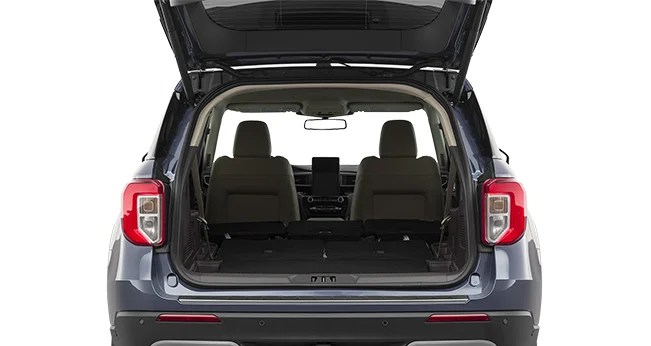
On size alone, the 2018–2021 Chevrolet Traverse comes out ahead with 23.0 cu ft behind the third row, 57.8 cu ft behind the second row, and 98.2 cu ft behind the third row. Additionally, it can tow up to an estimated 5,000 pounds when properly equipped with the 3.6L V6.4

The Traverse has more room for cargo and interior space overall, but if you tow, the Explorer has the advantage.
Pricing
The 2021 Ford Explorer and Chevrolet Traverse are newer model years and we currently have a limited number in our inventory. See below for average CarMax prices for previous model years of both vehicles.†
Ford Explorer
2017—Average prices less than $27,500†
2018—Average prices less than $29,500†
2019—Average prices less than $30,500†
2020—Average prices less than $41,500†
Chevrolet Traverse
2017—Average prices less than $22,500†
2018—Average prices less than $30,000†
2019—Average prices less than $31,000†
2020—Average prices less than $36,500†
Safety Ratings
The 2019 Ford Explorer achieved an overall five-star safety rating by the National Highway Traffic Safety Administration (NHTSA). The 2019 Chevrolet Traverse also achieved an overall five-star safety rating. Certain vehicles may have unrepaired safety recalls. Click here to look up a specific vehicle.
2019 Ford Explorer

Frontal Barrier Crash Rating Test: A head-on collision between two similar vehicles traveling at 35 mph.
Overall: 5/5
Side Barrier Crash Rating Test: A vehicle standing in an intersection sustains driver-side impact from a vehicle moving at 38.5 mph.
Overall: 5/5
Side Pole Crash Rating Test: A vehicle slides sideways at 20 mph and impacts a tree or telephone pole.
Overall: 5/5
2019 Chevrolet Traverse
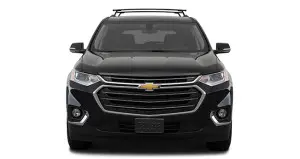
Frontal Barrier Crash Rating Test: A head-on collision between two similar vehicles traveling at 35 mph.
Overall: 4/5
Side Barrier Crash Rating Test: A vehicle standing in an intersection sustains driver-side impact from a vehicle moving at 38.5 mph.
Overall: 5/5
Side Pole Crash Rating Test: A vehicle slides sideways at 20 mph and impacts a tree or telephone pole.
Overall: 5/5
Reliability
The Ford Explorer and Chevrolet Traverse have similar reliability ratings, however, the Explorer comes out ahead overall. Although the average cost of repairs each year is higher with the Explorer, the Traverse has a greater chance of needing severe repairs and is taken in for repairs twice as often as the Explorer.
Ford Explorer:
RepairPal gave the Ford Explorer an overall reliability rating of 3.5 out of 5 stars, which RepairPal describes as Above Average.
Cost: RepairPal reports that the average total annual cost for repairs and maintenance on a Ford Explorer is $732, compared to an average of $573 for midsize SUVs and $652 for all the vehicles RepairPal considered in its dataset.
Frequency: According to RepairPal, Ford Explorer owners bring their vehicles into a repair shop for unscheduled repairs an average of .2 times per year, compared to an average of .4 times for midsize SUVs and .4 times for all the vehicle models RepairPal considered in its dataset.
Severity: RepairPal reported that the probability of a repair being a severe or major issue is 14% for the Ford Explorer, compared to an average of 13% for midsize SUVs and 12% for all the vehicles RepairPal considered in its dataset.
Chevrolet Traverse:
RepairPal gave the Chevrolet Traverse an overall reliability rating of 3.0 out of 5 stars, which RepairPal describes as Average.
Cost: RepairPal reports that the average total annual cost for repairs and maintenance on a Chevrolet Traverse is $656, compared to an average of $573 for midsize SUVs and $652 for all the vehicles RepairPal considered in its dataset.
Frequency: According to RepairPal, Chevrolet Traverse owners bring their vehicles into a repair shop for unscheduled repairs an average of .4 times per year, compared to an average of .4 times for midsize SUVs and .4 times for all the vehicle models RepairPal considered in its dataset.
Severity: RepairPal reported that the probability of a repair being a severe or major issue is 18% for the Chevrolet Traverse, compared to an average of 13% for midsize SUVs and 12% for all the vehicles RepairPal considered in its dataset.
RepairPal Reliability Ratings are based on the actual cost, frequency, and severity of unscheduled repairs and maintenance on make/model data for select 2010–2019 vehicles. The reliability of a specific vehicle may vary depending on its maintenance and driving history, model year, trim, and features.
*RepairPal Reliability Ratings are provided by RepairPal and CarMax is not responsible for their accuracy. These ratings are based on RepairPal Reliability data as of 12/31/2018. Learn more.
Performance
Powered by a 310 hp 3.6L V6 engine, the current-generation (2018–2021) Chevrolet Traverse is matched to a nine-speed automatic transmission. For model years 2018–2021, the Traverse gets an EPA-estimated 17 mpg city, 25 mpg highway, and 20 mpg combined with all-wheel drive or 18 mpg city, 27 mpg highway, and 21 mpg combined with front-wheel drive.††
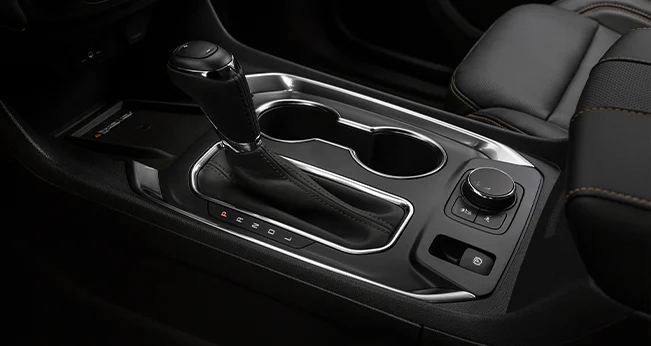
This powerful engine will go from zero to 60 in 7.1 seconds regardless of whether you have front-wheel drive or all-wheel drive (according to the manufacturer, when new).
The 2020–2021 Explorer has four powertrains, all paired to a ten-speed automatic transmission. The base engine is a 300 hp, 2.3L four-cylinder with 310 lb-ft of torque. For model years 2020–2021, the Explorer achieves 21 mpg city, 28 mpg highway, and 24 mpg combined with rear-wheel drive or 21 mpg city, 28 mpg highway, and 24 mpg combined with four-wheel drive.††

There's also an available 365 hp, 3.0L V6 with 380 lb-ft of torque on 2020–2021 models. The 2020–2021 performance-focused ST trim gets a more powerful version of this engine with 400 hp and 415 lb-ft of torque with a top speed of 143 mph. It'll zoom to 60 mph in just 5.2 seconds.
Whether you go for the Explorer or the Traverse depends on what you value most, fuel-sipping credentials or pure power.
Emissions
If you're looking to keep emissions low, your best choice here is the 2.3L Ford Explorer. Take a look below for detailed figures.
Chevrolet Traverse
According to EPA estimates, the FWD/AWD 2021 Chevrolet Traverse's EPA-estimated tailpipe greenhouse gas emissions are 420/439 grams per mile.
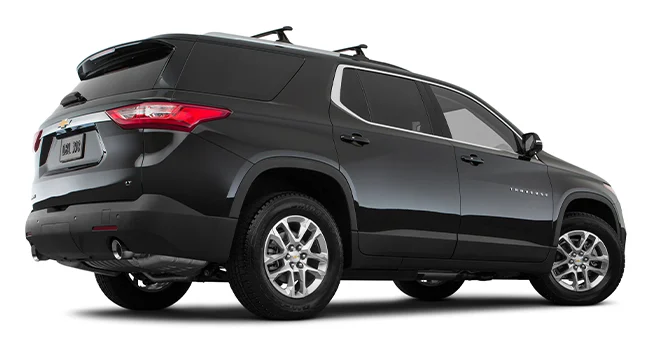
Ford Explorer
The RWD/4WD 2021 Ford Explorer's EPA-estimated tailpipe greenhouse gas emissions vary depending on the engine:

2.3L four-cylinder: 373/386 grams per mile
3.0L V6: 431/445 grams per mile
3.3L V6: 324/361 grams per mile
These estimates are based on a brand-new model. Visit fueleconomy.gov for more details.
The Bottom Line
The Ford Explorer and Chevrolet Traverse are both midsize SUVs made for busy lives. They have plenty of room for friends, family, pets, and cargo, and include fully-featured infotainment systems and the capability to tow. The Traverse offers a larger interior with seating for one additional passenger, while the Explorer offers a wider range of engines with its ability to go longer between fuel stops.
Want to learn more? Check out these related articles:
